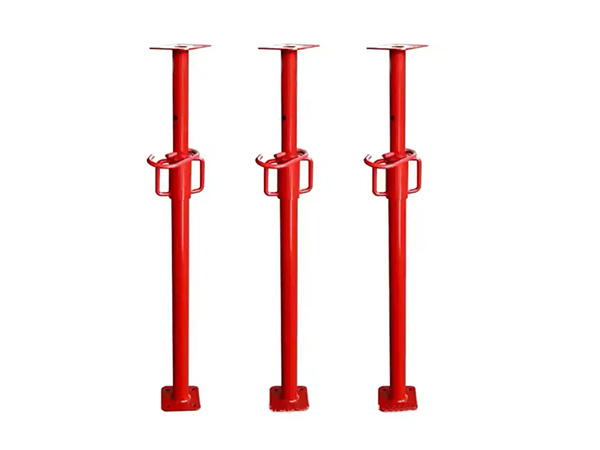- Site Navigation -

Aluminum Formwork Steel Support
Aluminum Formwork Steel Support is a specialized load-bearing component designed exclusively for aluminum formwork systems—widely used in high-rise residential,commercial,and pref......
Aluminum Formwork Steel Support is a specialized load-bearing component designed exclusively for aluminum formwork systems—widely used in high-rise residential,commercial,and prefabricated construction.As a critical"link"between the lightweight aluminum formwork panels and the ground,it is engineered to bear vertical loads(concrete self-weight,construction live loads)and maintain formwork alignment during concrete pouring,while matching the aluminum formwork’s modularity,high reusability,and rapid assembly characteristics.Unlike generic steel supports,it features aluminum-formwork-specific connections,optimized load distribution,and lightweight yet high-strength construction,making it indispensable for ensuring the efficiency and safety of aluminum formwork construction.
Core Structural Design&Key Components
The structure of Aluminum Formwork Steel Support is tailored to synergize with aluminum formwork systems,focusing on"compatibility"and"load-bearing efficiency":
High-Strength Steel Body:The main load-bearing part is made of Q355B carbon steel(yield strength≥355MPa)or alloy steel,processed into seamless steel tubes(common diameters:Φ48mm,Φ60mm;wall thickness:3.5-5mm)or cold-formed steel profiles.The tube-type design balances lightweight(30%lighter than heavy-duty steel supports)and rigidity,enabling easy on-site handling—critical for matching aluminum formwork’s quick-installation needs.
Aluminum Formwork Adapter:The top of the support is equipped with a custom adapter plate(usually 150×150mm,with pre-drilled holes matching aluminum formwork’s bolt spacing:200-300mm).This adapter directly bolts to the aluminum formwork’s beam or rib,ensuring a tight,non-slip connection—avoiding the"loosening gap"common with generic supports.
Precision Adjustable Mechanism:Equipped with a threaded lead screw(trapezoidal thread,M24-M30)and a forged steel adjusting nut,it allows height fine-tuning within 150-300mm(adjustment accuracy±1mm).This compensates for ground unevenness and aluminum formwork assembly errors,ensuring consistent formwork elevation(e.g.,floor slab thickness control within±3mm).
Stabilizing Base&Reinforcements:The bottom features an enlarged base plate(200×200mm,thickness≥6mm)to distribute load and prevent sinking into the ground.Key joints(adapter-screw,screw-tube)are welded with triangular steel ribs(thickness≥5mm)to enhance shear resistance,avoiding deformation under peak loads(up to 30kN per support).
Core Advantages for Aluminum Formwork Systems
Modular Compatibility:The top adapter plate is standardized to fit mainstream aluminum formwork systems(e.g.,PERI,DOKA,local Chinese brands),eliminating the need for custom modification—cutting assembly time by 20%compared to generic supports.
High Load-to-Weight Ratio:Q355B steel enables a single support to bear 25-30kN(sufficient for 200-250mm thick concrete slabs)while weighing only 8-12kg,making it easy for 1-2 workers to install—aligning with aluminum formwork’s labor-saving design.
Corrosion Resistance:The surface is treated with electrostatic powder coating(epoxy-polyester hybrid powder,thickness 60-80μm)or hot-dip galvanizing(zinc layer≥85μm),passing 500-hour salt spray tests.This ensures durability through 200+reuses(matching aluminum formwork’s service life),reducing replacement costs.
Anti-Loosening Safety:The adjusting nut is equipped with a spring washer or a lockable pin to prevent vibration-induced loosening during concrete pouring—addressing a major safety risk in high-rise aluminum formwork construction.
Application&Usage Guidelines
Load Matching:Select support specifications based on concrete thickness and formwork layout—e.g.,200mm thick floor slabs useΦ48mm supports(25kN load capacity)spaced at 1.2-1.5m;250mm thick slabs requireΦ60mm supports(30kN capacity)spaced≤1.2m.
Correct Assembly:Ensure the adapter plate is fully bolted to the aluminum formwork(torque 40-50N·m)and the base plate is placed on a level,compacted surface(use a steel pad if ground is soft).The support must be vertical(deviation≤0.5°)to avoid eccentric loading.
Inspection Before Pouring:Check for loose nuts,cracked welds,or bent tubes—replace damaged supports immediately.Verify height adjustment to ensure formwork elevation matches design requirements(e.g.,floor slab top elevation).
Reuse&Maintenance:After formwork stripping,clean concrete residue from the support and check the coating for damage(touch up with anti-rust paint if scratched).Store in a dry area to prevent corrosion,ensuring consistent performance across reuses.
Typical Application Scenarios
High-Rise Residential Floors:Used to support aluminum formwork for floor slabs,beams,and internal walls—leveraging modularity to enable"one floor per week"construction cycles.
Prefabricated Component Casting:Supports aluminum formwork for precast concrete walls or slabs in factories,ensuring precise component dimensions for on-site assembly.
Commercial Building Core Tubes:Provides stable support for aluminum formwork in high-load core tube structures(e.g.,elevator shafts),with anti-loosening features ensuring safety during high-vibration concrete pumping.
In summary,Aluminum Formwork Steel Support is a"purpose-built"component that maximizes the efficiency and safety of aluminum formwork systems.Its compatibility,load-bearing performance,and durability make it a key enabler for fast,high-quality construction in modern high-rise and prefabricated projects.








